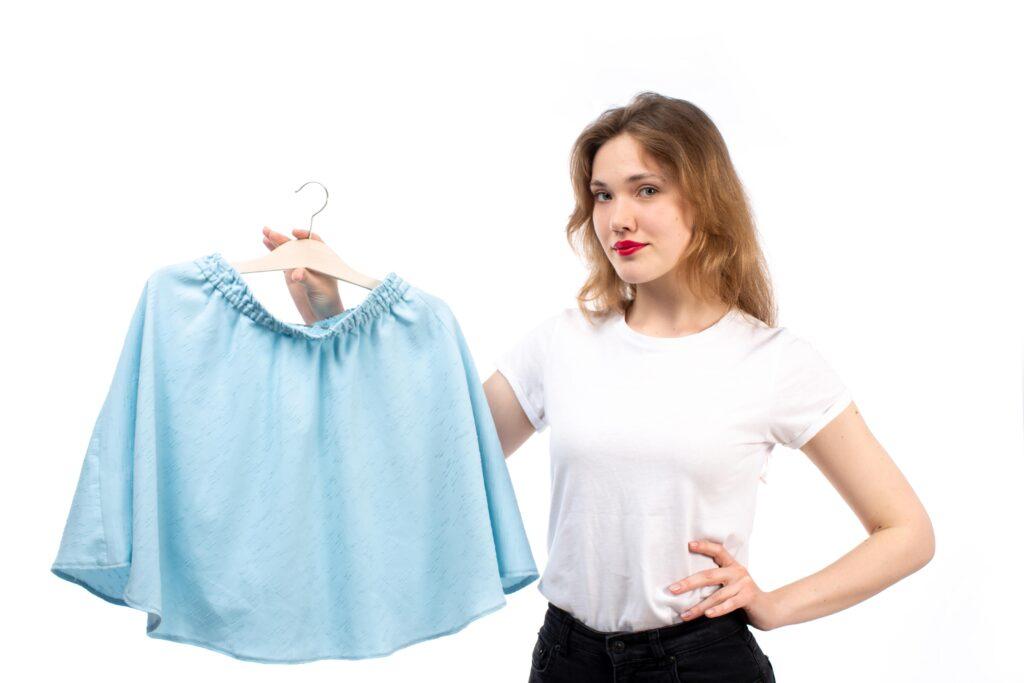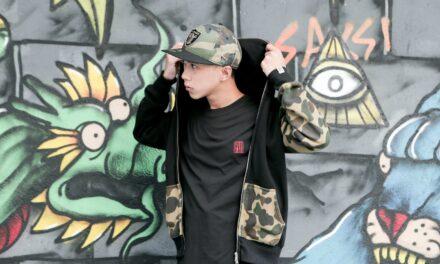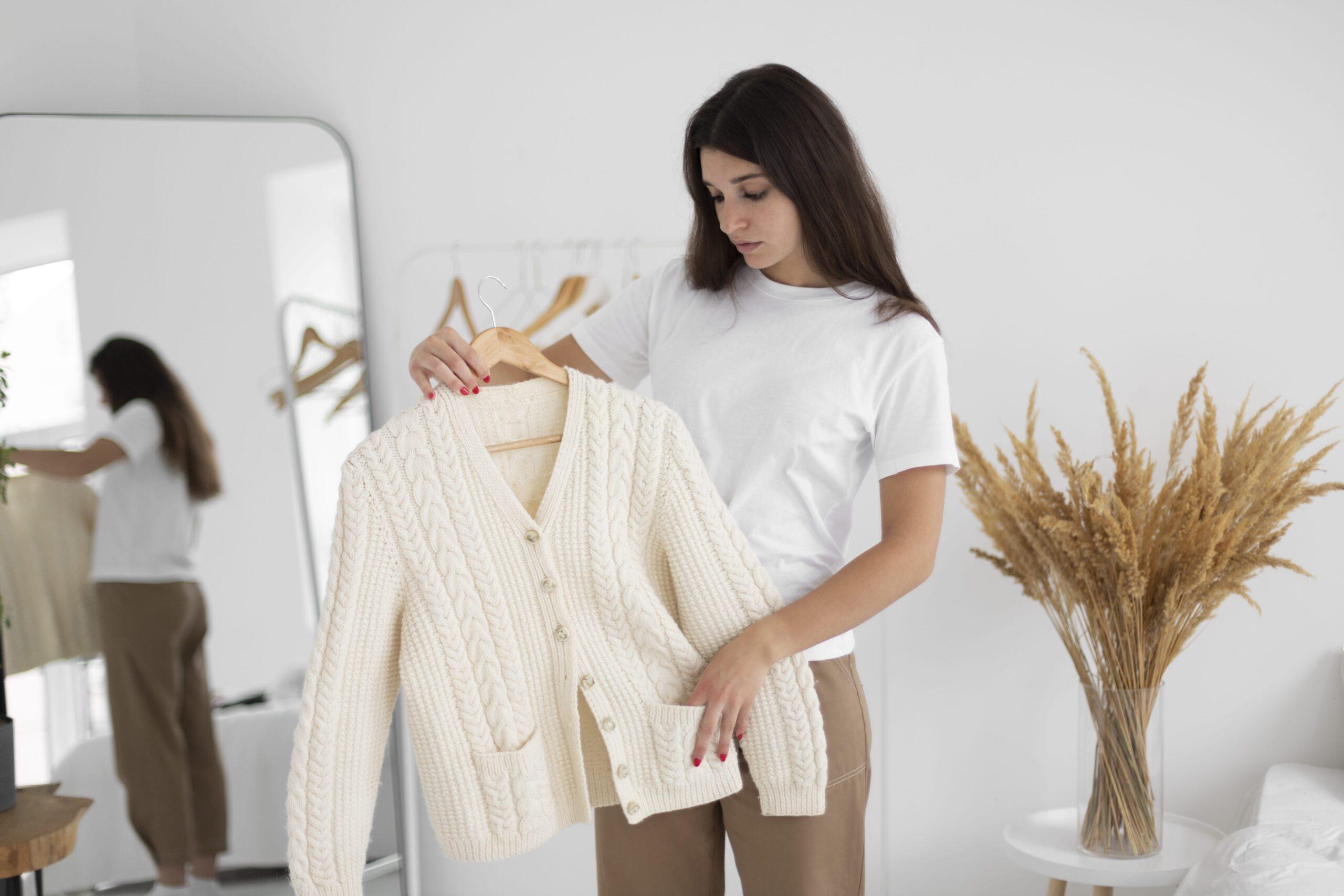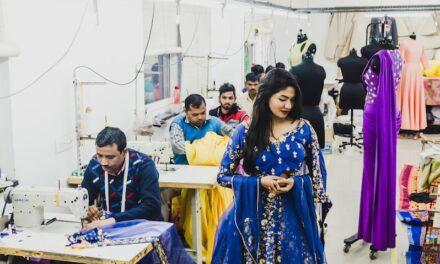Understanding shirt vs blouse difference is important and can help you choose the right outfit for any occasion, whether it’s for business or casual wear.
A shirt typically refers to a cloth top that is designed for men or women and can be worn with pants, shorts, or skirts. They are often made of durable materials and feature buttons down the front.
Tucked shirts are a popular fashion choice for those who want a more modern look. On the other hand, blouses are typically designed for women and have more feminine details such as ruffles, lace, or tucks.
They are often made of lighter materials and may be paired with skirts or dressy bottoms. Both shirts and blouses are popular garments in the world of fashion.
Understanding this simple term is crucial in creating an appropriate look for different levels of formality in fashion. So next time someone asks if you prefer a tucked shirt with a tie collar or a blouse with a skirt and trousers, you’ll know exactly what they mean!
Definition of Shirts and Blouses
Clear definition of what a shirt is
A shirt is a type of clothing that covers the upper body, usually made of cotton or other breathable materials. It has buttons down the front, a collar, cuffs, and sleeves. Many blouses are available in various styles such as formal dress shirts, casual t-shirts, and polo shirts.
Additionally, fashion enthusiasts can opt for a wrap blouse or a saree blouse to add a touch of elegance to their wardrobe.
Clear definition of what a blouse is
A blouse is a popular fashion item that covers the upper body, primarily designed for women. It can be made from various fabrics such as silk, chiffon, cotton, or polyester. Unlike shirts, blouses have more intricate designs with ruffles or lace details and are often paired with skirts or dress pants for formal occasions.
In recent years, blouses have also become a trendy top for casual wear, with many advertisements showcasing how to style them with high-waisted jeans or shorts.
Explanation on how they differ from each other
The main difference between shirts and blouses lies in their design and purpose. While both are worn to cover the upper body, shirts are more versatile and can be worn by both men and women for different occasions – whether it’s for work or casual wear. On the other hand, blouses tend to be more feminine in style with delicate details such as embroidery or lace trims making them suitable for formal fashion occasions.
Additionally, blouses often have a defined waistline that accentuates the figure, while shirts typically have a looser fit. Overall, both shirts and blouses can be great options for a stylish top to complete any outfit.
Another key difference between shirts and blouses lies in their fit and style. Shirts are typically cut straight down from the chest to the waist, making them a classic top type in fashion. On the other hand, blouses tend to be tailored to fit closer around the waistline, creating an hourglass silhouette that is both fashionable and stylish.
In terms of styling options, there are many ways you can mix up your wardrobe with these two types of clothing items. For example, a dress shirt can be styled for a formal or casual look, while a wrap blouse adds a feminine touch to any outfit.
Both pieces offer versatility in terms of style and can be paired with various bottoms. Additionally, the word shirt can refer to both dress shirts and casual shirts, making it important to consider the occasion when choosing the appropriate style.
- Pairing a crisp white button-up shirt with jeans and tucking it in at the waist creates a classic casual look. For those who prefer a more feminine touch, many blouses can also be tucked in for a similar effect, including the traditional saree blouse.
- Dressing up your outfit with a fitted blouse or top tucked into high-waisted pants creates an elegant yet professional look. There are many blouses to choose from, depending on the type of shirt you prefer.
- Wearing an oversized shirt or blouse over shorts gives off an effortless chic vibe. This type of top, especially from Banana Republic, is perfect for a casual yet stylish look.
- Layering a sheer blouse or dress shirt over a camisole or top of any type with a pencil skirt creates a sophisticated look. For more options, try shopping at Banana Republic.
Characteristics of Shirt vs Blouse Difference
Different Types of Fabrics Used for Shirts and Blouses
Shirts and blouses may look similar, but there are some differences in the fabrics used to make them. Dress shirts, for example, are typically made of cotton or a cotton blend.
The fabric is usually thin and lightweight, making it breathable and comfortable to wear. Many blouses, on the other hand, can be made from a variety of fabrics such as silk, chiffon, or polyester.
These fabrics tend to be more delicate than those used in dress shirts. If you’re looking for a stylish top, Banana Republic offers a variety of options in different materials.
Common Features Found in Shirts
Shirts and tops are typically considered a more formal garment than blouses. They often feature collars and buttons down the front. Some common features found in dress shirts and tops include:
- Tie collar: A collar that can accommodate a necktie
- Chest pocket: A small pocket located on the chest
- Long sleeves: Sleeves that extend past the wrist
- Button cuffs: Cuffs that fasten with buttons
- Plain front: A shirt or blouse without pleats or other embellishments on the front, perfect for a simple and elegant top.
Casual shirts and tops may have short sleeves instead of long sleeves. They may also have different types of collars such as a polo collar or no collar at all. Blouses are also a popular choice for casual wear.
Common Features Found in Blouses
Blouses and tops tend to be more versatile than dress shirts and can be worn for both casual and formal occasions. Some common features found in many blouses and tops include:
- Wrap blouse: A blouse that wraps around the body
- Saree blouse: A top or dress shirt designed specifically to be worn with a saree.
- Short sleeves: Sleeves that do not extend past the elbow, commonly found on dress shirts, blouses, and tops.
- Buttons or snaps on the back or side instead of down the front for blouse, dress shirt, and top.
- Pencil skirt pairing: Often paired with a blouse, shirt, or top for a professional look.
Blouses or shirts can also come in many different styles such as off-the-shoulder, peplum, or bell sleeves. Tops are also available in various designs to suit your preference.
Differences in Style and Fit
Shirts and blouses are two of the most popular tops. While they may look similar, there are some key differences between them that you should know.
How Shirts are Designed to Fit on Men’s Bodies
Shirts for men and tops for women are designed differently to fit their respective body types. Men’s shirts typically have a looser fit and are designed to accommodate a wider range of body types, while women’s tops are more form-fitting and tailored to accentuate their curves. This is because men tend to have broader shoulders and narrower hips than women.
Men’s shirts come in different types such as dress shirts, casual shirts, polo shirts, t-shirts, etc. Each type has its own unique style that suits different occasions or activities. Unfortunately, the keywords “blouse” and “top” cannot be added as they are typically used to refer to women’s clothing.
- Dress Shirts: These are formal shirts that often come with long sleeves and a stiff collar suitable for wearing with a suit or dress pants. Blouses and tops are also available for those looking for a more feminine touch.
- Casual Shirts: These are more relaxed than dress shirts and can be worn untucked with jeans or shorts. Blouses and tops can also be worn for a more feminine look.
- Polo Shirts: Made from knitted fabric, these short-sleeved collared tops are perfect for sports activities or casual outings. If you’re looking for a more feminine option, consider a blouse instead.
- T-Shirts: These are simple cotton tops that can be dressed up or down depending on the occasion. Blouses can also be a great option for a more formal look.
How Blouses are Designed to Fit on Women’s Bodies
Blouses and tops for women, on the other hand, come in a wide variety of styles and fits. They usually have more shaping around the waistline compared to men’s shirts. This is because women tend to have curvier figures than men.
Women’s blouses and shirts also come in different types such as dressy blouses, casual tops, button-up blouses, etc., each suited for different occasions.
- Dressy Blouses: These typically feature more elegant fabrics such as silk, chiffon, or satin and can be paired with skirts or dress pants for formal events. They are also known as dressy shirts or tops.
- Casual Tops: These are more relaxed than dressy blouses and can be worn with jeans or shorts. They can also be called shirts.
- Button-up blouses, also known as shirts or tops, have buttons down the front and can come in a variety of styles such as sleeveless, short-sleeved, long-sleeved, etc.
Differences in Style between Men’s Shirts and Women’s Blouses
Apart from fit, there are also differences in style between men’s shirts, women’s blouses, and tops. Men’s shirts tend to have simpler designs with fewer embellishments. They often feature neutral colors like white, black, blue, or gray.
Women’s shirts and tops, on the other hand, come in a wider range of colors and patterns. They often feature feminine details like ruffles, lace, embroidery or prints, making them versatile options for any occasion.
Sleeve lengths also differ between men’s shirts and women’s blouses. Men’s shirts typically come in short sleeves or long sleeves while women’s blouses can come in various sleeve lengths including sleeveless tops.
Examples of When to Wear a Shirt or Blouse
Appropriate Occasions for Wearing a Shirt
Shirts, blouses, and tops are versatile pieces of clothing that can be worn in various settings. They come in different styles, colors, and materials, making them suitable for both casual and formal occasions.
- Casual events – Shirts or blouses made from lightweight fabrics like cotton or linen are perfect for casual occasions such as picnics, barbecues, and beach parties. Pair them with denim jeans or shorts for a relaxed look. Tops in the same materials can also work well for a comfortable and stylish outfit.
- Business casual attire – For business casual events like networking events or meetings, opt for collared shirts or blouses made from silk or polyester blends. Tops complement the dress pants well and give off an air of professionalism.
- Formal events – Shirts and blouses with crisp collars and cuffs made from high-quality materials such as silk or Egyptian cotton are ideal for formal events like weddings, galas, and black-tie affairs. Tuck them into dress pants or trousers and wear dress shoes to complete the look. Tops can also be a great option for women, paired with a skirt or dress pants for a sophisticated ensemble.
Appropriate Occasions for Wearing a Blouse
Blouses and tops are typically considered more feminine than shirts due to their design elements such as ruffles, lace trims, and sheer fabrics. They are often worn by women but can also be styled by men who prefer a more fluid silhouette.
- Casual events – Light-colored blouses or tops made from breathable fabrics like cotton or chiffon work well for daytime outings such as brunches or shopping trips. Pair them with skinny jeans or flowy skirts for a chic look. A shirt can also be a great option for a more structured and polished outfit.
- Business casual attire – Blouses or tops in solid colors without any embellishments work well in professional settings where you want to make an impression without being too flashy. Pair them with dress pants and closed-toe shoes to maintain the formality of the outfit. A shirt can also be a great option for a more structured look.
- Formal events – For formal occasions such as weddings or dinner parties, opt for blouses or shirts with intricate designs like embroidery or beading. Pair them with dress pants or skirts and wear high heels to complete the look. Alternatively, you can also choose a top with elegant details to elevate your outfit.
Comparison between Formal, Casual, and Business Attire
Formal, casual, and business attire all require different clothing pieces such as shirt, blouse, or top to achieve the desired look. Here’s how you can differentiate between them when choosing what to wear.
- Formal attire – Dress codes for formal events usually require guests to wear tuxedos or evening gowns. Shirts and blouses worn in these settings are usually made from high-quality materials such as silk or satin, with a top notch finish.
- Business attire – Business attire is more conservative than casual wear but less formal than black-tie events. Tops, shirts, and blouses worn in this setting should be professional-looking without being too flashy.
- Casual attire – Casual outfits are typically worn for informal occasions like weekend brunches or picnics. Shirts, blouses, and tops used in a casual setting can be made from lightweight fabrics like cotton or linen.
History of Shirts and Blouses: Cultural Significance
Historical significance behind wearing shirts
Shirts and blouses have been a part of human clothing for thousands of years. The first recorded use of the word “shirt” was in the 14th century, but evidence suggests that people have been wearing some form of shirt or top since ancient times. In fact, the ancient Egyptians wore linen shirts as early as 5,000 years ago.
Throughout history, shirts, blouses, and tops have served different purposes depending on the culture and time period. For example:
- In medieval Europe, shirts and blouses were often worn as an undergarment beneath heavier outerwear, while tops were reserved for more formal occasions.
- During the Renaissance era, men’s shirts and women’s blouses became more ornate with ruffled collars, cuffs, and tops.
- In the 18th century, men’s dress shirts, also known as blouses or tops, were typically made from linen or cotton and featured elaborate embroidery.
- In the 19th century, women began to wear tailored blouses, also known as tops, that resembled men’s dress shirts.
Today, shirts, blouses, and tops are worn for a variety of reasons including fashion, comfort, and practicality. They come in many different styles and materials to suit every occasion.
Historical significance behind wearing blouses
Like shirts, blouses and tops have also been around for centuries. However, their history is a bit more complicated than that of their male counterpart.
The term “blouse” originally referred to a loose-fitting garment worn by peasants in various European countries during the 18th century. It wasn’t until later that blouses, shirts, and tops became associated with women’s clothing.
In the late 19th century and early 20th century, women began to wear tailored blouses, also known as shirts or tops, as part of their work attire. These blouses were often made from lightweight fabrics like silk or cotton and featured high necklines with buttons down the front.
During World War II, women who worked outside the home often wore practical blouses or shirts with short sleeves and no frills. This trend continued into the 1950s, when women’s blouses and tops became more feminine with ruffles, lace, and other decorative elements.
Today, blouses, shirts, and tops are a staple of women’s fashion. They come in many different styles and materials to suit every occasion, from casual cotton button-downs to elegant silk blouses for formal events.
Evolution of Shirt and Blouse Styles Over Time
Changes in shirt styles over time
Shirts and blouses have been a staple in fashion for centuries. From the 16th century, when men wore ruffled shirts with elaborate collars, to the modern-day top that comes in various styles for both men and women, the evolution of shirts and blouses has been quite remarkable.
One significant change in shirt and blouse styles is the introduction of different collar types. In the early days, only one type of collar was used for tops, but as time went on, more collar types were introduced. Today we have point collars, spread collars, button-down collars, and even band collars for both shirts and tops.
Another significant development is the use of different fabrics to make shirts, blouses, and tops. Initially, cotton was used to make most shirts; today silk and other materials are also used.
The design of shirts, blouses, and tops has also evolved over time. The classic button-up shirt has been modified to include features such as pockets or short sleeves for a more casual look.
Changes in blouse styles over time
Blouses, also known as tops or shirts, have undergone significant changes since their inception. In ancient times, women wore sarees instead of blouses; it was not until later that blouses became popular.
One notable change is the introduction of different necklines on blouses and shirts. There are now halter tops with high necklines or V-necklines that show off some skin.
Another trend that has emerged over time is using bows as an accessory on blouses, shirts, and tops. Bows can add a touch of elegance to any blouse, shirt, or top style; they can be tied around the neck or at the back.
Silk is another material that has become increasingly popular for making blouses, shirts, and tops due to its luxurious feel and appearance.
The length of shirts and tops has also changed over time; some modern-day shirts and tops are cropped while others fall below the waistline.
Understanding the Distinctions between Shirts and Blouses
In conclusion, understanding the differences between shirts, blouses, and tops is important for creating a polished and put-together look. Shirts are typically more structured with collars and buttons, while blouses are often more flowy with feminine details like ruffles or lace.
Tops can encompass both styles and can vary in fit, with shirts being more tailored to the body and blouses offering looser fits.
When deciding whether to wear a shirt or blouse, consider the occasion and your personal style. A crisp button-down shirt or flowy blouse can both be great options, but don’t forget about the versatility of a stylish top that can be dressed up or down for any event.
The history of shirts and blouses, also known as tops, dates back centuries, with cultural significance in various parts of the world. Over time, top styles have evolved to reflect changing trends and societal norms.
Overall, knowing the distinctions between shirts, blouses, and tops can help elevate your fashion choices. Experiment with different styles to find what works best for you.
FAQs
Q: Can men wear blouses?
While traditionally considered women’s clothing, there are many unisex or gender-neutral options available today that could be considered “blouse-like” in style. Ultimately, anyone can wear a shirt or top whatever they feel comfortable in.
Q: What’s the difference between a tunic and a blouse?
Tunics are longer than traditional blouses and can be considered as a type of shirt or top, often reaching mid-thigh or knee-length. They may also have unique features like slits on the sides or high-low hems.
Q: Are oversized shirts considered blouses?
It depends on the specific shirt in question – some oversized tops may be considered more “blouse-like” due to their flowy fit or feminine details like ruffles or lace.
Q: Can you tuck a blouse into jeans?
A: Yes! Tucking a shirt or top into high-waisted jeans can create an effortlessly chic look.
Q: Can blouses be casual?
Absolutely! There are many casual blouse options available, such as cotton or linen styles that can be dressed down with jeans or shorts. You can also consider a shirt or top for a more versatile look.













